WGB
New Member
With the entire rear end out of the car the aged look of the rear rubber fuel hoses started to get to me so I collected the three hoses - 2 off e-bay and one from autohausaz as well as a new filter and a packet of copper sealing washes ( The washers cost 20 cents each - there are 5 of them - from autohausaz and the whole job only added up to about 60 to 70 dollars including postage).
This setup was current for all K jets until February 1979 production when the hoses were changed to permit a faster cold startup.
My car was January 1979 production and the hoses will be the same for all the V8's and probably the 280SE motor as well.
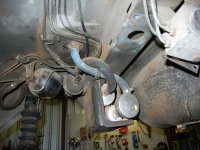
The first thing is to remove the plastic shroud so that you have access from all sides. It is held by three 10mm headed self tappers and mine was missing the front right one hence it had a rattle. The shroud has two holes in the bottom and a 10mm socket on an extension will get at the screw heads from underneath - I used a 1/4" drive as it is a bit crowded in there.
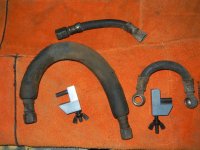
They look worse out than in. The small fuel line clamps were used but in reality later models have a valve on the end of the pump before the banjo connection so there is very little fuel loss so long as this valve is left alone.
In my case I loosened it when I undid the banjo connection so I removed it and fitted a new sealing washer just to be sure.
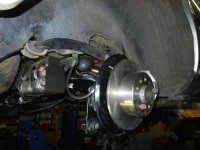
Finished job with the shroud off
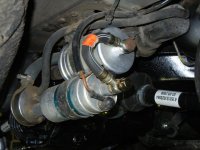
Pump to filter hose has a banjo joint at each end and needs 4 copper sealing rings to seal both ends none of which come with the new Bosch filter as well an extra o-ring to seal the one way valve in the end of the pump which will almost certainly be disturbed while undoing the connections.
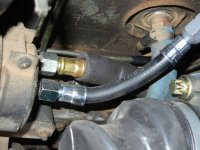
Views of the new accumulator hoses from front and rear. The insulated hose goes from the other end of the fuel filter onto the accumulator and the smaller uninsulated hose goes from the end of the pressure accumulator to the main fuel line.
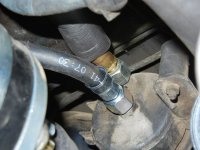
And here is the finished job with the plastic shroud cleaned up and now securely fastened by three self tappers. Interestingly the 10 mm self tappers are a shorter version of those used to hold on the front wings so I had several spares (thankyou again Nathan).
I also wrote the date of the filter change with black texta on the body of the fuel filter for easy future reference.
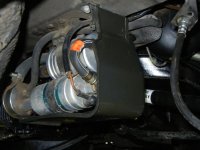
I will probably replace the two rubber hoses that go from the other end of the fuel line to the motor but that will be for another day.
Bill
This setup was current for all K jets until February 1979 production when the hoses were changed to permit a faster cold startup.
My car was January 1979 production and the hoses will be the same for all the V8's and probably the 280SE motor as well.

The first thing is to remove the plastic shroud so that you have access from all sides. It is held by three 10mm headed self tappers and mine was missing the front right one hence it had a rattle. The shroud has two holes in the bottom and a 10mm socket on an extension will get at the screw heads from underneath - I used a 1/4" drive as it is a bit crowded in there.

They look worse out than in. The small fuel line clamps were used but in reality later models have a valve on the end of the pump before the banjo connection so there is very little fuel loss so long as this valve is left alone.
In my case I loosened it when I undid the banjo connection so I removed it and fitted a new sealing washer just to be sure.

Finished job with the shroud off

Pump to filter hose has a banjo joint at each end and needs 4 copper sealing rings to seal both ends none of which come with the new Bosch filter as well an extra o-ring to seal the one way valve in the end of the pump which will almost certainly be disturbed while undoing the connections.

Views of the new accumulator hoses from front and rear. The insulated hose goes from the other end of the fuel filter onto the accumulator and the smaller uninsulated hose goes from the end of the pressure accumulator to the main fuel line.

And here is the finished job with the plastic shroud cleaned up and now securely fastened by three self tappers. Interestingly the 10 mm self tappers are a shorter version of those used to hold on the front wings so I had several spares (thankyou again Nathan).
I also wrote the date of the filter change with black texta on the body of the fuel filter for easy future reference.

I will probably replace the two rubber hoses that go from the other end of the fuel line to the motor but that will be for another day.
Bill
Last edited:
